2021 VOLVO V90 CROSS COUNTRY tow
[x] Cancel search: towPage 631 of 683
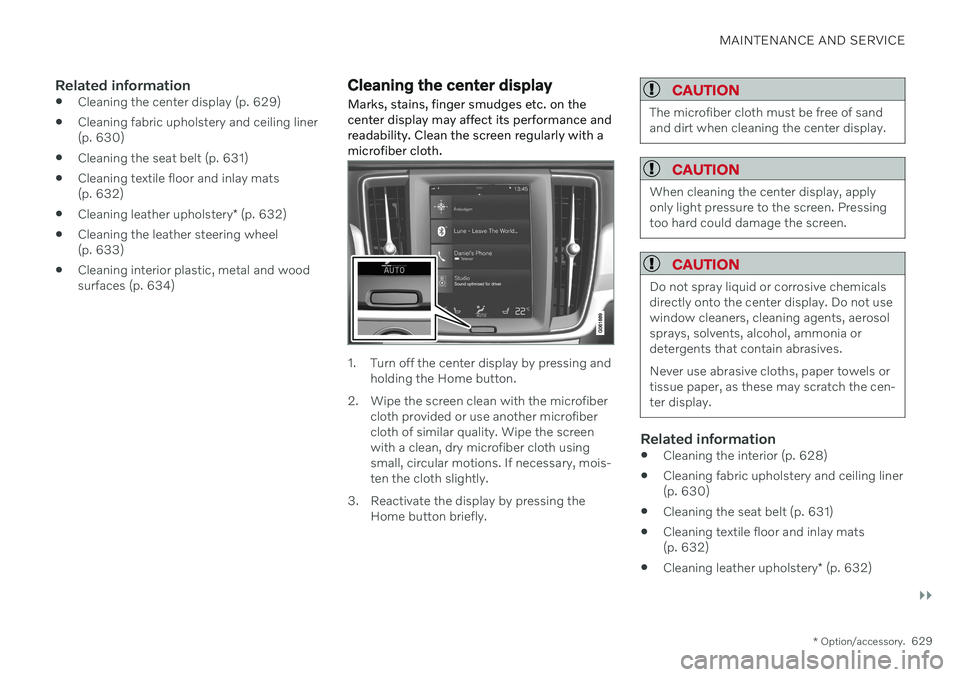
MAINTENANCE AND SERVICE
}}
* Option/accessory.629
Related information
Cleaning the center display (p. 629)
Cleaning fabric upholstery and ceiling liner (p. 630)
Cleaning the seat belt (p. 631)
Cleaning textile floor and inlay mats(p. 632)
Cleaning leather upholstery
* (p. 632)
Cleaning the leather steering wheel(p. 633)
Cleaning interior plastic, metal and woodsurfaces (p. 634)
Cleaning the center display
Marks, stains, finger smudges etc. on the center display may affect its performance andreadability. Clean the screen regularly with amicrofiber cloth.
1. Turn off the center display by pressing and holding the Home button.
2. Wipe the screen clean with the microfiber cloth provided or use another microfiber cloth of similar quality. Wipe the screenwith a clean, dry microfiber cloth usingsmall, circular motions. If necessary, mois-ten the cloth slightly.
3. Reactivate the display by pressing the Home button briefly.
CAUTION
The microfiber cloth must be free of sand and dirt when cleaning the center display.
CAUTION
When cleaning the center display, apply only light pressure to the screen. Pressingtoo hard could damage the screen.
CAUTION
Do not spray liquid or corrosive chemicals directly onto the center display. Do not usewindow cleaners, cleaning agents, aerosolsprays, solvents, alcohol, ammonia ordetergents that contain abrasives. Never use abrasive cloths, paper towels or tissue paper, as these may scratch the cen-ter display.
Related information
Cleaning the interior (p. 628)
Cleaning fabric upholstery and ceiling liner (p. 630)
Cleaning the seat belt (p. 631)
Cleaning textile floor and inlay mats(p. 632)
Cleaning leather upholstery
* (p. 632)
Page 635 of 683
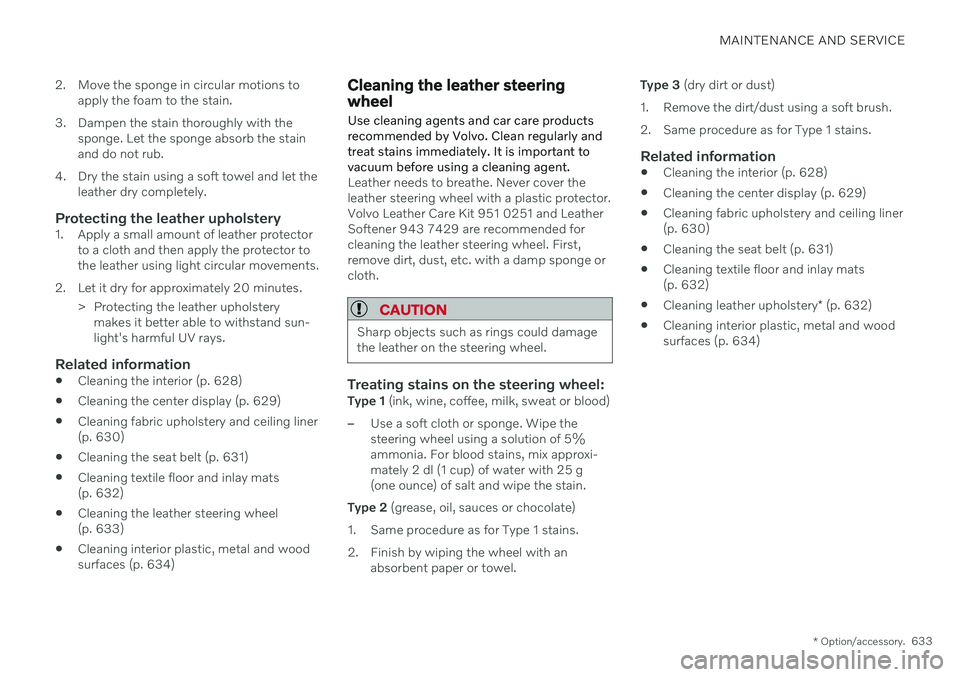
MAINTENANCE AND SERVICE
* Option/accessory.633
2. Move the sponge in circular motions to
apply the foam to the stain.
3. Dampen the stain thoroughly with the sponge. Let the sponge absorb the stain and do not rub.
4. Dry the stain using a soft towel and let the leather dry completely.
Protecting the leather upholstery1. Apply a small amount of leather protector to a cloth and then apply the protector tothe leather using light circular movements.
2. Let it dry for approximately 20 minutes. > Protecting the leather upholsterymakes it better able to withstand sun-light's harmful UV rays.
Related information
Cleaning the interior (p. 628)
Cleaning the center display (p. 629)
Cleaning fabric upholstery and ceiling liner(p. 630)
Cleaning the seat belt (p. 631)
Cleaning textile floor and inlay mats(p. 632)
Cleaning the leather steering wheel(p. 633)
Cleaning interior plastic, metal and wood surfaces (p. 634)
Cleaning the leather steering wheel
Use cleaning agents and car care products recommended by Volvo. Clean regularly andtreat stains immediately. It is important tovacuum before using a cleaning agent.
Leather needs to breathe. Never cover the leather steering wheel with a plastic protector.Volvo Leather Care Kit 951 0251 and LeatherSoftener 943 7429 are recommended forcleaning the leather steering wheel. First,remove dirt, dust, etc. with a damp sponge orcloth.
CAUTION
Sharp objects such as rings could damage the leather on the steering wheel.
Treating stains on the steering wheel:Type 1 (ink, wine, coffee, milk, sweat or blood)
–Use a soft cloth or sponge. Wipe the steering wheel using a solution of 5%ammonia. For blood stains, mix approxi-mately 2 dl (1 cup) of water with 25 g(one ounce) of salt and wipe the stain.
Type 2 (grease, oil, sauces or chocolate)
1. Same procedure as for Type 1 stains.
2. Finish by wiping the wheel with an absorbent paper or towel. Type 3
(dry dirt or dust)
1. Remove the dirt/dust using a soft brush.
2. Same procedure as for Type 1 stains.
Related information
Cleaning the interior (p. 628)
Cleaning the center display (p. 629)
Cleaning fabric upholstery and ceiling liner (p. 630)
Cleaning the seat belt (p. 631)
Cleaning textile floor and inlay mats(p. 632)
Cleaning leather upholstery
* (p. 632)
Cleaning interior plastic, metal and woodsurfaces (p. 634)
Page 646 of 683

||
MAINTENANCE AND SERVICE
644
Changing rear window wipers
Lift the wiper arm from the window and pull the lower section of the blade to the right.
Grasp the center of the wiper blade and lift it from the window to the stop posi-tion.
NOTE
When the wiper arm is halfway folded out, it will stop in a locking position that helpsprevent the arm from falling back onto therear window. The wiper arm must bepulled past the locking position stop inorder to change the wiper blade.
Grip the lower part of the blade and pull to the right until the blade loosens from thearm.3. Press the new wiper blade until it clicks
into place. Check to make sure the bladeis securely in place.
4. Fold the wiper arm back toward the win- dow.
CAUTION
Check the blades regularly. Neglected maintenance shortens the life of theblades.
Related information
Using the rain sensor (p. 184)
Using the windshield and headlight wash- ers (p. 186)
Using automatic rear window wipingwhen backing up (p. 188)
Activating and deactivating the rain sen-sor's memory function (p. 185)
Using the rear window wiper/washer(p. 187)
Filling washer fluid (p. 646)
Putting the wiper blades in service posi-tion (p. 645)
Replacing windshield wiper blades(p. 644)
Using the windshield wipers (p. 183)
Wiper blades and washer fluid (p. 183)
Replacing windshield wiper blades
The wiper blades help remove water from the windshield and rear window. Along with thewasher fluid, they are designed to clean theglass and help improve visibility while driving.The windshield and rear window wiperblades can be replaced.
Page 657 of 683
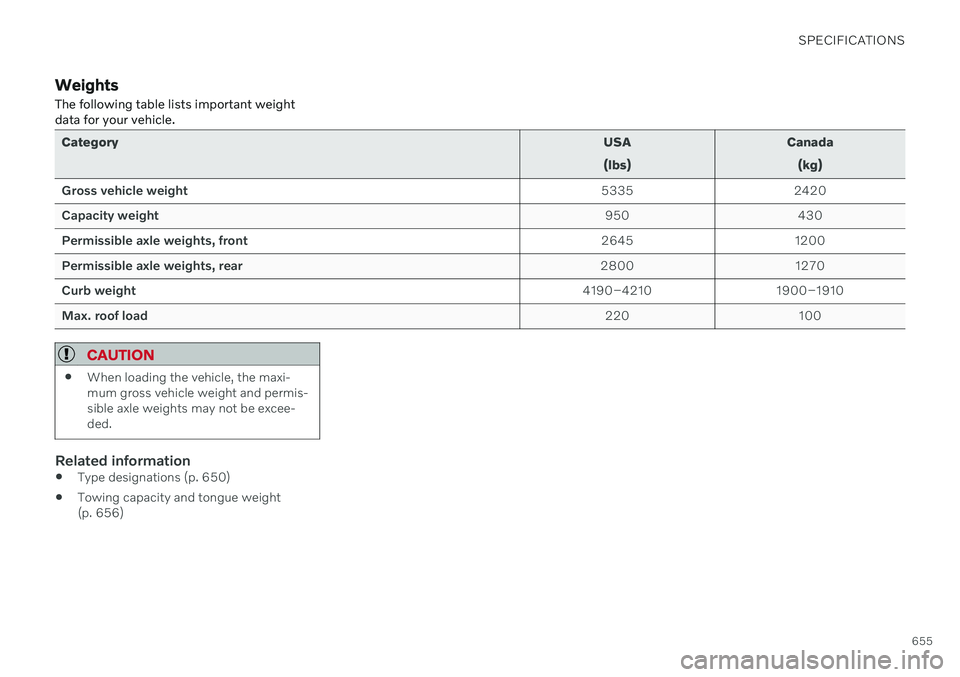
SPECIFICATIONS
655
WeightsThe following table lists important weight data for your vehicle.
Category USA
(lbs) Canada
(kg)
Gross vehicle weight 5335 2420
Capacity weight 950 430
Permissible axle weights, front 2645 1200
Permissible axle weights, rear 2800 1270
Curb weight 4190–4210 1900–1910
Max. roof load 220 100
CAUTION
When loading the vehicle, the maxi- mum gross vehicle weight and permis-sible axle weights may not be excee-ded.
Related information
Type designations (p. 650)
Towing capacity and tongue weight (p. 656)
Page 658 of 683
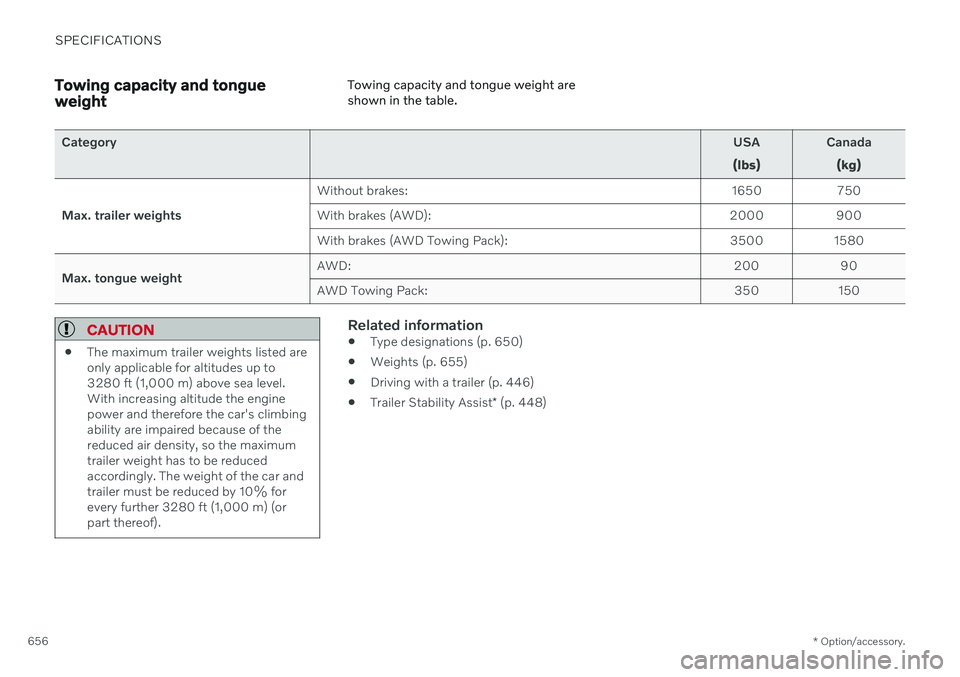
SPECIFICATIONS
* Option/accessory.
656
Towing capacity and tongue weight Towing capacity and tongue weight are shown in the table.
Category
USA
(lbs) Canada
(kg)
Max. trailer weights Without brakes:
1650 750
With brakes (AWD): 2000 900
With brakes (AWD Towing Pack): 3500 1580
Max. tongue weight AWD:
200 90
AWD Towing Pack: 350 150
CAUTION
The maximum trailer weights listed are only applicable for altitudes up to3280 ft (1,000 m) above sea level.With increasing altitude the enginepower and therefore the car's climbingability are impaired because of thereduced air density, so the maximumtrailer weight has to be reducedaccordingly. The weight of the car andtrailer must be reduced by 10% forevery further 3280 ft (1,000 m) (orpart thereof).
Related information
Type designations (p. 650)
Weights (p. 655)
Driving with a trailer (p. 446)
Trailer Stability Assist
* (p. 448)
Page 669 of 683
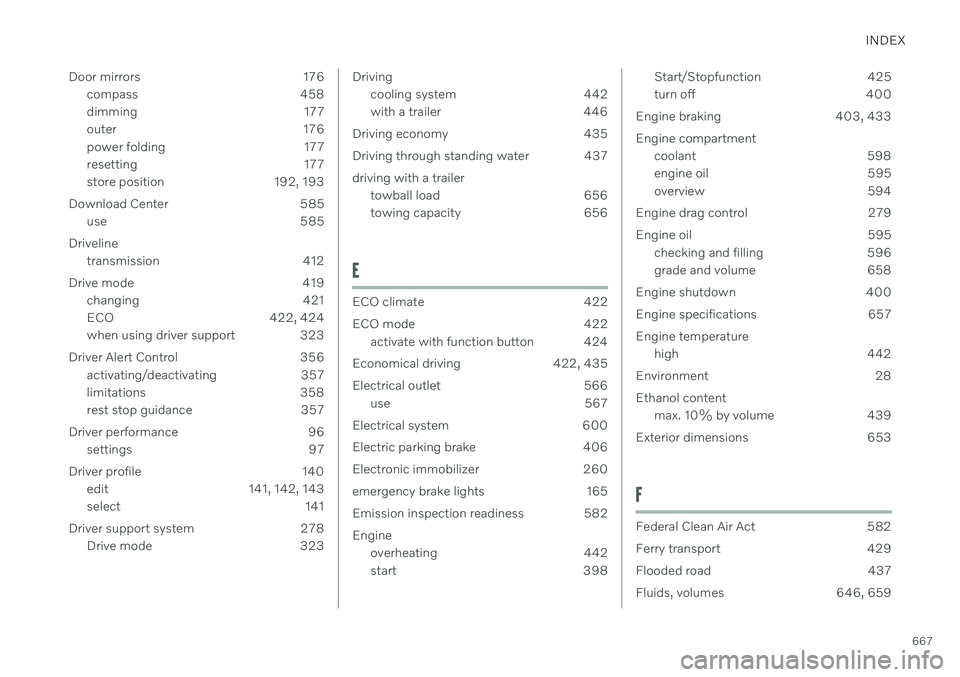
INDEX
667
Door mirrors 176
compass 458
dimming 177
outer 176
power folding 177
resetting 177
store position 192, 193
Download Center 585 use 585
Driveline transmission 412
Drive mode 419 changing 421
ECO 422, 424
when using driver support 323
Driver Alert Control 356 activating/deactivating 357
limitations 358
rest stop guidance 357
Driver performance 96 settings 97
Driver profile 140 edit 141, 142, 143
select 141
Driver support system 278 Drive mode 323
Drivingcooling system 442
with a trailer 446
Driving economy 435
Driving through standing water 437driving with a trailer towball load 656
towing capacity 656
E
ECO climate 422
ECO mode 422
activate with function button 424
Economical driving 422, 435
Electrical outlet 566 use 567
Electrical system 600
Electric parking brake 406
Electronic immobilizer 260
emergency brake lights 165
Emission inspection readiness 582 Engine overheating 442
start 398
Start/Stopfunction 425
turn off 400
Engine braking 403, 433 Engine compartment coolant 598
engine oil 595
overview 594
Engine drag control 279
Engine oil 595 checking and filling 596
grade and volume 658
Engine shutdown 400
Engine specifications 657Engine temperature high 442
Environment 28Ethanol content max. 10% by volume 439
Exterior dimensions 653
F
Federal Clean Air Act 582
Ferry transport 429
Flooded road 437
Fluids, volumes 646, 659
Page 678 of 683
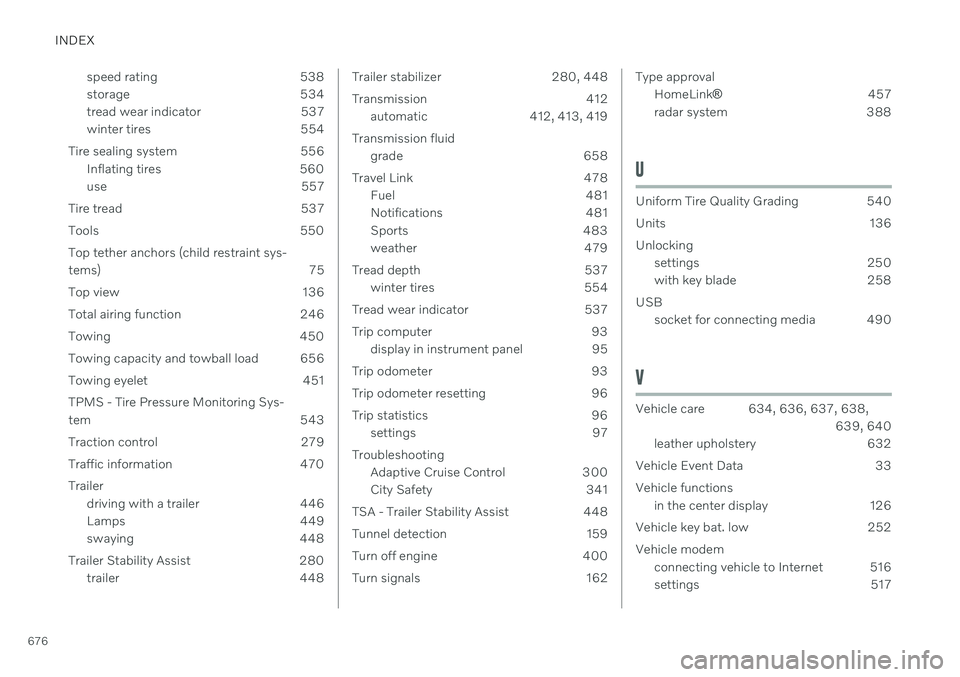
INDEX
676speed rating 538
storage 534
tread wear indicator 537
winter tires 554
Tire sealing system 556 Inflating tires 560
use 557
Tire tread 537
Tools 550Top tether anchors (child restraint sys-
tems) 75
Top view 136
Total airing function 246
Towing 450
Towing capacity and towball load 656
Towing eyelet 451TPMS - Tire Pressure Monitoring Sys-
tem 543
Traction control 279
Traffic information 470 Trailer driving with a trailer 446
Lamps 449
swaying 448
Trailer Stability Assist 280 trailer 448
Trailer stabilizer 280, 448
Transmission 412automatic 412, 413, 419
Transmission fluid grade 658
Travel Link 478 Fuel 481
Notifications 481
Sports 483
weather 479
Tread depth 537 winter tires 554
Tread wear indicator 537
Trip computer 93 display in instrument panel 95
Trip odometer 93
Trip odometer resetting 96
Trip statistics 96 settings 97
Troubleshooting Adaptive Cruise Control 300
City Safety 341
TSA - Trailer Stability Assist 448
Tunnel detection 159
Turn off engine 400
Turn signals 162Type approval HomeLink ® 457
radar system 388
U
Uniform Tire Quality Grading 540
Units 136Unlocking settings 250
with key blade 258
USB socket for connecting media 490
V
Vehicle care 634, 636, 637, 638,
639, 640
leather upholstery 632
Vehicle Event Data 33 Vehicle functions in the center display 126
Vehicle key bat. low 252 Vehicle modem connecting vehicle to Internet 516
settings 517
Page 682 of 683
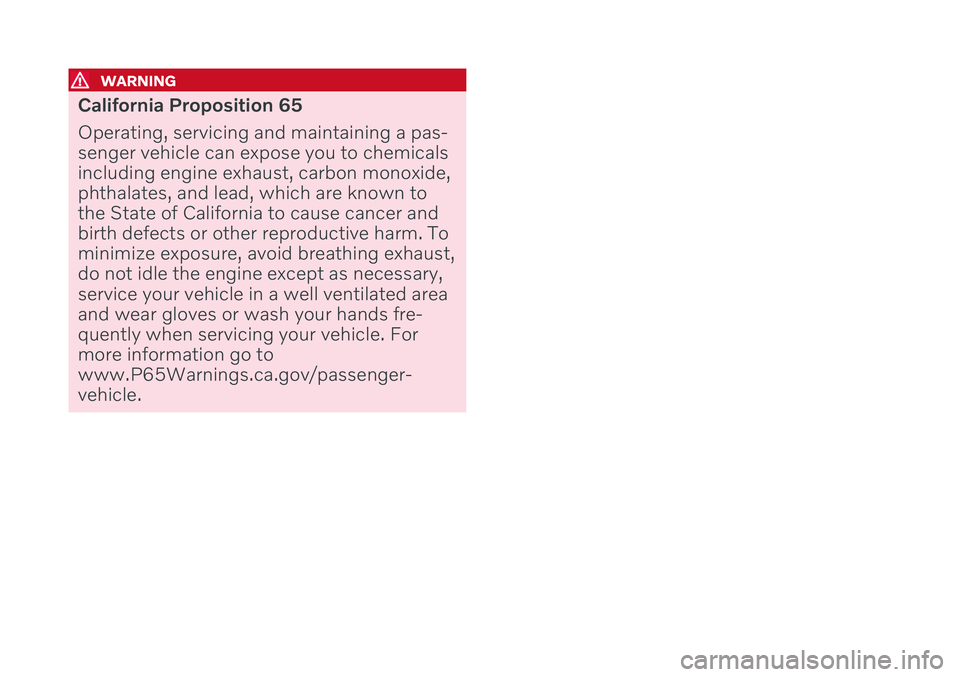
WARNING
California Proposition 65 Operating, servicing and maintaining a pas- senger vehicle can expose you to chemicalsincluding engine exhaust, carbon monoxide,phthalates, and lead, which are known tothe State of California to cause cancer andbirth defects or other reproductive harm. Tominimize exposure, avoid breathing exhaust,do not idle the engine except as necessary,service your vehicle in a well ventilated areaand wear gloves or wash your hands fre-quently when servicing your vehicle. Formore information go towww.P65Warnings.ca.gov/passenger-vehicle.